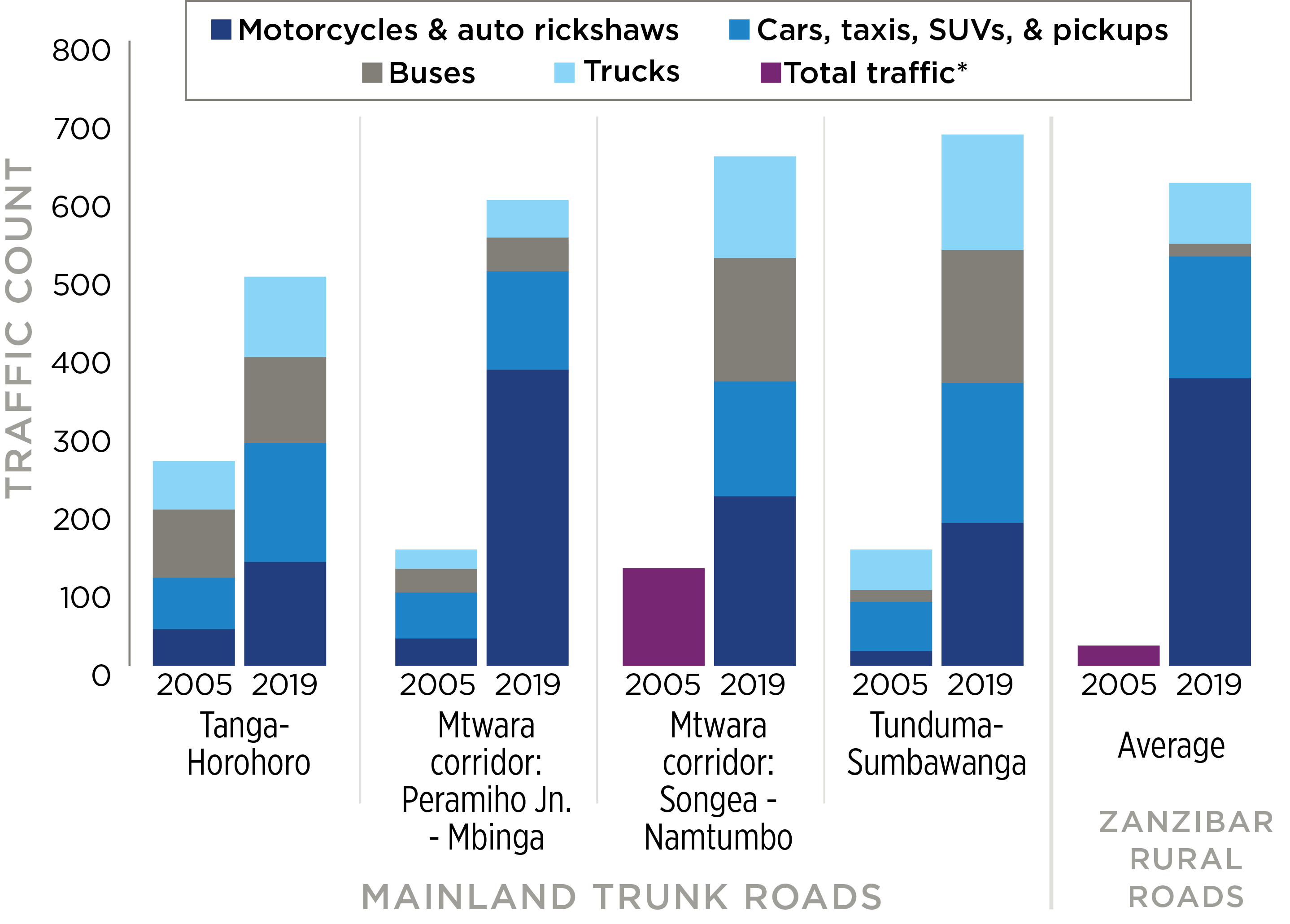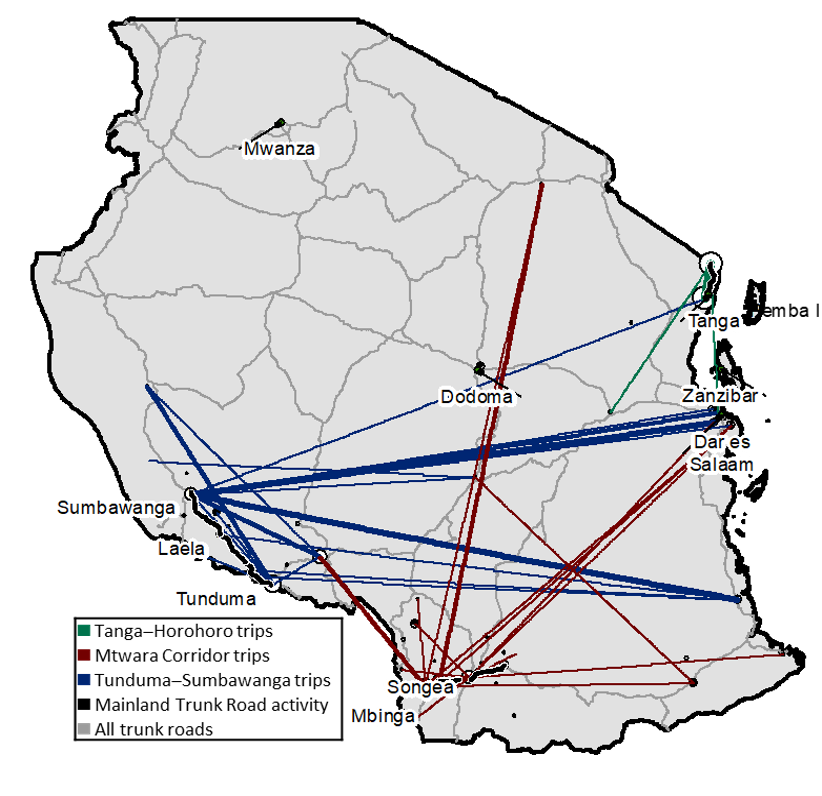Program Overview
MCC’s $695 million Tanzania Compact (2008-2013) funded the $405 million Transport Sector Project, which upgraded trunk roads in mainland Tanzania, rural roads on Pemba Island, and the Mafia Island Airport runway. 190 km of roads were completed at compact close, with the remaining 278 km later completed by the Government of Tanzania. The project aimed to increase cash crop revenue in mainland Tanzania and Pemba, and increase tourist spending on Mafia Island by reducing transportation costs.
Evaluator Description
MCC commissioned Mathematica to conduct an independent final performance evaluation of the Transport Sector Project. Mathematica partnered with AidData for an impact evaluation of the Mainland Trunk Road and Zanzibar Rural Road Activities. Full report results and learning: https://data.mcc.gov/evaluations/index.php/catalog/218.
Key Findings
Transportation Costs, Traffic Growth and Road Use
- Paving roads led to large increases in travel speeds, and reductions in fuel and vehicle repair costs across all roads, leading to increased traffic volume.
- Investing in the national trunk road network greatly facilitated the movement of people and goods across regions and national borders.
Transportation Markets
- Reductions in vehicle operating costs led freight and passenger service providers to reduce prices for consumers and increase service provision along the project roads.
- Paving the runway at the Mafia Island Airport reduced aircraft operating costs, but without any reduction in fares or measurable increase in traffic.
Road Condition and Maintenance
Impact of Roads on Economic Activity
Evaluation Questions
This final performance and impact evaluation was designed to answer the following questions:
- 1
Were transportation costs reduced? How is the road being used, and how has this changed since before the investment? - 2
What is the likelihood that vehicle operating costs (VOC) savings will be passed on to consumers of transportation services? Did runway improvements reduce aircraft operating costs and increase traffic? - 3
What is the likelihood that the roads will be maintained? - 4
What was the impact of the road improvements on incomes in mainland Tanzania and on Pemba Island?
Detailed Findings
Transportation Costs, Traffic Growth and Road Use

Traffic growth along the Project roads
Travel times and vehicle operating costs – key determinants of transport costs – fell following the upgrades along all project roads. Average mainland travel speeds increased from 37 km/h to 70 km/h. This cut the 90 km journey from Mbinga to Songea from almost three hours to one and a half. On Pemba, speeds increased from 27 km/h to 59 km/h. Similarly, road condition, measured by road roughness, went from very poor to good across all roads. Facilitated by these better roads and shorter travel times, traffic volumes increased on all roads. From pre-project levels to 2019, annual traffic growth ranged from 5 to 17 percent on the mainland roads, and 28 to 39 percent on the Pemba roads.
Lower transport costs led to increased movement of people and goods for productive purposes. Travel on the mainland roads is primarily for work-related purposes and, on average, over longer distances than prior to the upgrade, including more long distance inter-urban travel. Freight vehicles primarily transport agricultural goods on the Tanga–Horohoro and Tunduma–Sumbawanga roads, whereas minerals and construction materials dominate on the Mtwara corridor.
Transportation Markets

TANROADS network condition over time
The road improvements appear to have affected transportation prices and service. On the mainland roads, freight prices dropped 10 to 25 percent following the upgrade, depending on the road. Passenger fares, which are regulated, also came down following the upgrade, and the number of scheduled services along the project roads increased. On Pemba, transportation services have expanded, and road users reported a greater availability of transport options and satisfaction with costs. While roads improvements lowered transport costs, the Mafia Island runway upgrade did not. Aircraft operating costs went down, but there was no apparent change in ticket prices.
Road Condition and Maintenance
Effective road maintenance is critical to realizing their full economic benefits; however, in Tanzania chronic underfunding threatens sustainability. In 2019 road agencies covered at most 60 percent of routine maintenance on the mainland roads and 30-40 percent on Pemba. They also struggle to fund the necessary periodic maintenance funds required to preserve the long-term structural integrity of their road network.
Impact of Roads on Economic Activity

Spatial distribution and frequency of trips, excluding international trips
Reducing transportation costs between markets can facilitate greater economic integration and increased trade. Between 2012 and 2017, growth rates (measured by the intensity of satellite-viewed nighttime lights) were 2.6 percent higher in the urban areas that were most affected by the improved mainland trunk roads.
The evidence also suggests that communities along improved roads on Pemba may have experienced higher rates of asset accumulation (a difference of about 0.12 standard deviations) relative to comparable households that were not near the upgraded roads in the years following the upgrade. However, these results are not statistically significant.
Economic Rate of Return
MCC considers a 10% economic rate of return (ERR) as the threshold to proceed with investment.
| Original ERR | Evaluation-Based ERR | |
|---|---|---|
| Tanga–Horohoro | 14.7% | 15.2% |
| Tunduma–Sumbawanga | 20.2% | 3.4% |
| Mtwara corridor | 14.8% | 6.8% |
| Pemba roads | 11.6% | -3.9% |
| Transport Sector Project | 17.2% | 5.7% |
Lower ERRs for the Pemba roads and for the Tunduma -Sumbawanga and Mtwara corridor roads were driven by increases in road construction costs compared to what was originally planned. The MCC ERR for the Tunduma - Sumbawanga road were also higher because baseline traffic volume was overstated by giving equal weight to traffic counts in urban area and along rural segments. The evaluation-based ERRs also exclude indirect benefit streams from improved human capital and agricultural production, which were included in the original MCC ERR but are considered double-counting.
MCC Learning
Focus project objectives on all users of the roads, do not try to identify a specific sector.
Project development should focus on the root causes of an identified problem.
Investing in maintenance may have been more cost-effective.
Ensure the estimated economic rate of return (ERR) is not double-counting benefits.
Evaluation Methods

The exposure period was 33 - 80 months after construction. The performance evaluation included modeling (using HDM-4), trend analyses, pre-post, and ex-post methods. Quantitative data was collected over a two-month period in 2019.
The impact evaluations of the Mainland roads and Pemba roads used a difference-in-differences method to detect impacts of road improvements on economic growth rates, using daytime and nighttime lights satellite imagery from the Landsat and the Defense Meteorological Satellite programs, the Tanzanian Demographic and Health Survey, and geospatial location data of the road network and urban areas from the road agencies in Tanzania.
2020-002-2455


